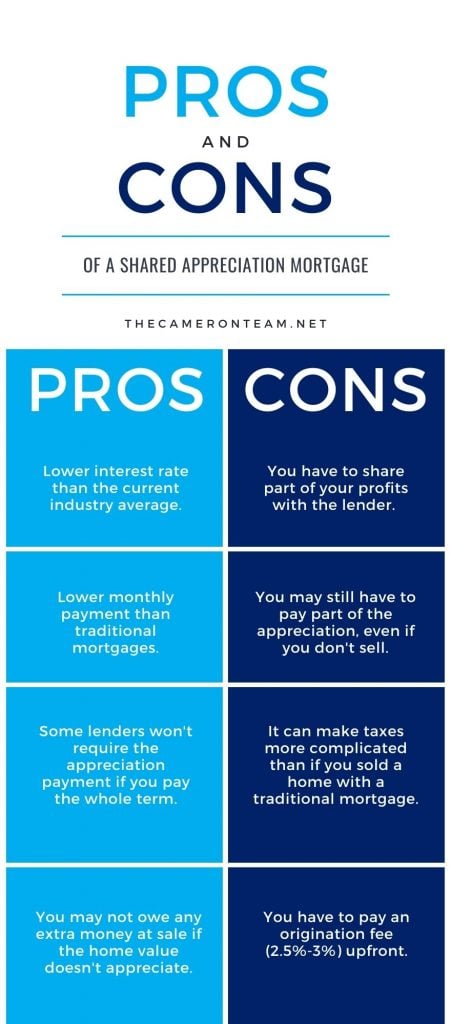A shared appreciation mortgage (SAM) is when a lender agrees to loan money to a home purchaser at an interest rate lower than the industry’s current average in exchange for a percentage of the property’s appreciated value when it’s sold.
When the home is sold, the borrower will then owe the lender any remaining principal plus a percentage of the amount the home’s price has increased. If the home’s value hasn’t increased or has decreased, the extra amount owed is $0, unless the borrower has agreed to a risk-adjusted discount, which is a % taken off the value of the home at the beginning of the mortgage. If there is no appreciation at the end of the loan, the borrower is responsible for paying the lender this percent of the original value.
Example
Susan wants to purchase a $250,000 home. She has saved a 20% down payment ($50,000) and would like to finance the rest with a shared appreciation mortgage. The lender agrees to lend her $200,000 if she pays them 20% of the appreciated value at sale. This lowers her monthly mortgage payment to a more affordable amount.
Five years down the road, Susan’s family has grown, and she needs a larger home. She decides to sell her property. Since she bought it, the home’s value has increased to $315,000. That is a $65,000 appreciation. She must pay 20% of that to the lender ($13,000) plus $176,000 of the mortgage principal that is still unpaid. After the sale of her home, she will gain $126,000 from the sale of the home that she can then apply to the purchase of a larger home.
Contingencies for Shared Appreciation Mortgages
The example above is a pretty basic SAM, but there are variations to the contingencies placed on these types of mortgages. One contingency may make it that the borrower only pays the appreciation to the lender if the home is sold within the first few years. This would help the lender recoup lost interest from the property being sold too soon. After all, many banks make money off the interest they charge every month.
Another contingency may phase out the interest over time, so the borrower owes nothing by the end of the mortgage. This would encourage the borrower to pay back the loan in full and not sell. Thus, the lender would still make money off the reduced interest.
It’s important to fully understand the contingencies of the SAM, because if there is no wording to make that interest phase out after the loan is fully paid off, the borrower will still owe the lender a percentage of the appreciated value – even if they don’t sell. That money would then have to come out of pocket or from other financing.
Who Benefits from a Shared Appreciation Mortgage?
SAMs can have deadlines that range from 10 years to 30 years, and may have terms that require payment, even if the borrower hasn’t made any gains in appreciation. They have origination fees (a 2.5%-3% fee paid upfront to the lender for processing the loan) and can create a bit of a mess when it comes to taxes due the unconventional flow of money. For these reasons, they aren’t the first choice for many home buyers. But if you choose to pursue one, make sure you talk to an accountant about how it could affect your finances.
SAMs are most popular among investors and flippers, people who renovate homes and then sell them. They specialize in reading the market and increasing a property’s value in a short amount of time, so a 10-year deadline isn’t a huge issue.
Are Shared Equity Agreements the Same as Shared Appreciation Mortgages?
A shared equity agreement (SEA) is similar to a SAM, except it’s a way for homeowners to tap into the power of their property’s equity. SEAs are less like second mortgages or equity loans and more like money advancements. Many offer a lump sum with 0% interest and no monthly payments, so the borrower owes basically nothing (except an origination fee and appraisal fee) until the property is sold, the first mortgage is refinanced, or the deadline is met. If the home isn’t sold, the lender orders an appraisal and the borrower is required to pay what the lender gave them plus a % of the appreciated value. Like a SAM, if the home doesn’t appreciate, there may be a risk-adjusted fee. This can be paid “out of pocket” or by refinancing the home.
These agreements are best for borrowers with liquidity issues and low cash flow, who have been through some hard times and need money for home repairs or financial improvement. Otherwise, borrowers will benefit more from less risky options, like traditional home equity loans or HELOCs.
Should You Get a Share Appreciation Mortgage?
This has been a brief overview of SAMs. We recommend talking to a lender and accountant before deciding if a SAM is your best option. But keep in mind that SAMs (and SEAs) are riskier than traditional home loans but do have the benefit of a lower monthly payment. They best serve consumers not buying their “Forever Home”, but potentially looking to use the property as a short-term investment. SAMs aren’t available in every market or price range, as the lender is looking for properties that have less value volatility and the most potential for appreciation.
Are you looking to purchase a home in the Wilmington area? We can help!




